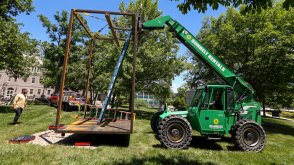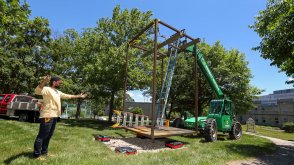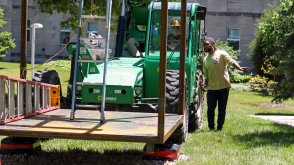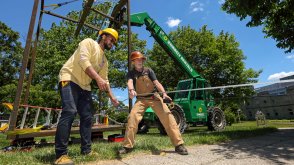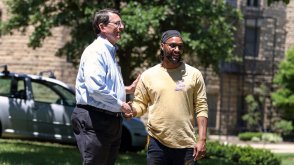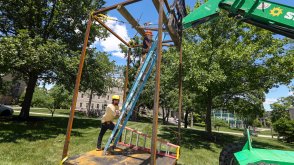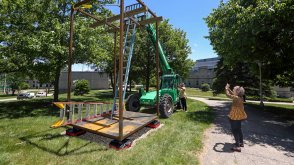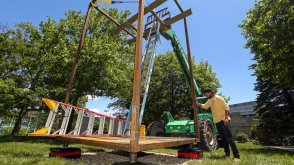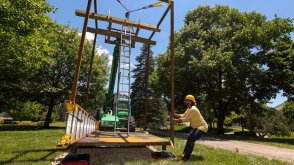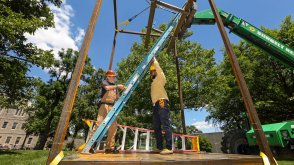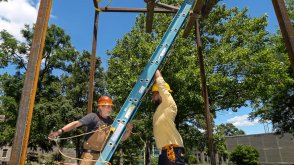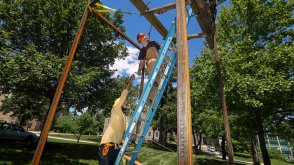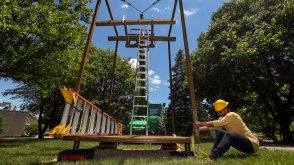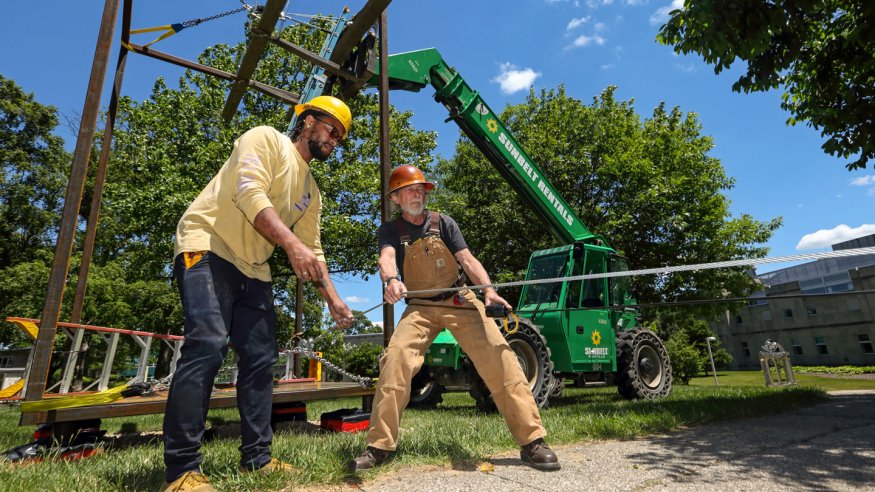
Front of Mind
Ohio Wesleyan Graduate’s ‘Back Porch’ Sculpture Gives Visibility to University’s Black Lives
DELAWARE, Ohio – Ohio Wesleyan University’s first artist-in-residence, Andrew Wilson, smiles broadly when he discusses the work involved in designing, creating, and installing his “Back Porch” outdoor sculpture – a 14-foot high, 8-foot wide, and 8-foot deep metal artwork that honors generations of OWU Black lives and legacies.
“Challenges are incredible opportunities,” said Wilson, a 2013 Ohio Wesleyan graduate who began working in January to design, create, and install the Corten steel cuboid sculpture. It was erected this week on the lawn outside OWU’s historic Elliott Hall.
An Inspiring Installation
“Back Porch” is inspired by the university’s House of Black Culture, a residential refuge for Black students and their allies for more than 50 years. Originally opened in 1970, the house was rebuilt in 2019.
“The back porch of the House of Black Culture was an important space for community, socializing, and rest,” said Wilson, who studied Fine Arts at Ohio Wesleyan and later earned a Master of Fine Arts degree from the University of California, Berkeley.
“It was a liminal space between outside and inside where we could be both highly visible and invisible – it was a space of respite for so many. ‘Back Porch’ is a way to honor this space and its importance to Black life at Ohio Wesleyan,” Wilson said.
The size of the artwork is based on the volume of the original screened-in back porch at the House of Black Culture, he said, adding to its meaning and magnitude. The sculpture’s location on Ohio Wesleyan’s academic campus also is significant, Wilson said.
‘Visibility and Representation’
“This work becoming part of the visual landscape of the academy and the area of serious thought and study will place Black space within those parameters as well,” he said. “Visibility and representation are important and valuable tools to see oneself as part of the whole.”
To ensure the sculpture continues to add the visibility and vitality of OWU Black lives over time, Wilson is collaborating with the Department of Performing Arts, Office of Multicultural Student Affairs, and others to discuss holding an annual event at the site and incorporating it as a recurring performance venue.
“The idea is to hold some sort of annual ritual at the site to recognize Black life at OWU,” Wilson said, “but also to let the people who live with it on campus help define it and how it is used every day.”
A First Look
Wilson created and installed “Back Porch” with assistance from sculpture professor Jonathan Quick. Together, they spent months building the piece inside Haycock Hall, OWU’s 3D arts building. On June 21-22, they used an industrial forklift to move the artwork and install it.
Estimated to weigh at least 2,000 pounds, “Back Porch” is so tall that it couldn’t be assembled inside the 3D arts building, making the installation the first time Wilson and Quick saw the full sculpture.
Quick said it has been rewarding to work with Wilson to create public art with such an important message. “It is reminiscent of reductive minimalist sculpture,” Quick said of the spare structure. “It’s meaning isn’t immediately accessible, but it is powerful.”
Once people read the bronze plaque being cast to explain “Back Porch,” Quick said, he believes everyone will be struck by its symbolism and significance in recognizing Black space and Black lives on campus.
Though people are able to view it now, the sculpture will be dedicated formally at 11 a.m. Oct. 2 during homecoming weekend. The public is invited.
A Homecoming Dedication
Wilson, who is heading to Texas next to complete a 10-month Galveston Artist Residency, will speak at the event, which he hopes incorporates a procession to and reception at the current House of Black Culture.
Also scheduled to speak are President Rock Jones and 1973 OWU alumna Lorry Luikart, who created The Ebb and Teena Haycock Public Art Endowment that supported Wilson’s artist residency and sculpture creation.
Luikart established the endowment in 2020 in memory of her father and mother. Ebb Haycock, a fine arts professor, created OWU’s first foundry and ran it for more than three decades until his retirement in 1985; Teena Haycock served as a secretary of the Theatre Department.
“I’m excited about the sculpture and about the dedication,” Wilson said. “I want to engage current students and alumni, and feature performances that honor Black life.”
Learn more about Wilson and his art at www.aiwart.com. Read more about Ohio Wesleyan’s House of Black Culture in the OWU Magazine.
Founded in 1842, Ohio Wesleyan University is one of the nation’s premier liberal arts universities. Located in Delaware, Ohio, the private university offers more undergraduate majors than many universities its size and competes in 24 NCAA Division III varsity sports. Through its signature program, The OWU Connection, Ohio Wesleyan teaches students to integrate knowledge across disciplines, build a diverse and global perspective, and apply knowledge in real-world settings. Ohio Wesleyan is featured in the book “Colleges That Change Lives” and included on the U.S. News & World Report and Princeton Review “best colleges” lists. Learn more at owu.edu.

